torque GMC ACADIA 2007 Owner's Manual
[x] Cancel search | Manufacturer: GMC, Model Year: 2007, Model line: ACADIA, Model: GMC ACADIA 2007Pages: 554, PDF Size: 2.76 MB
Page 23 of 554
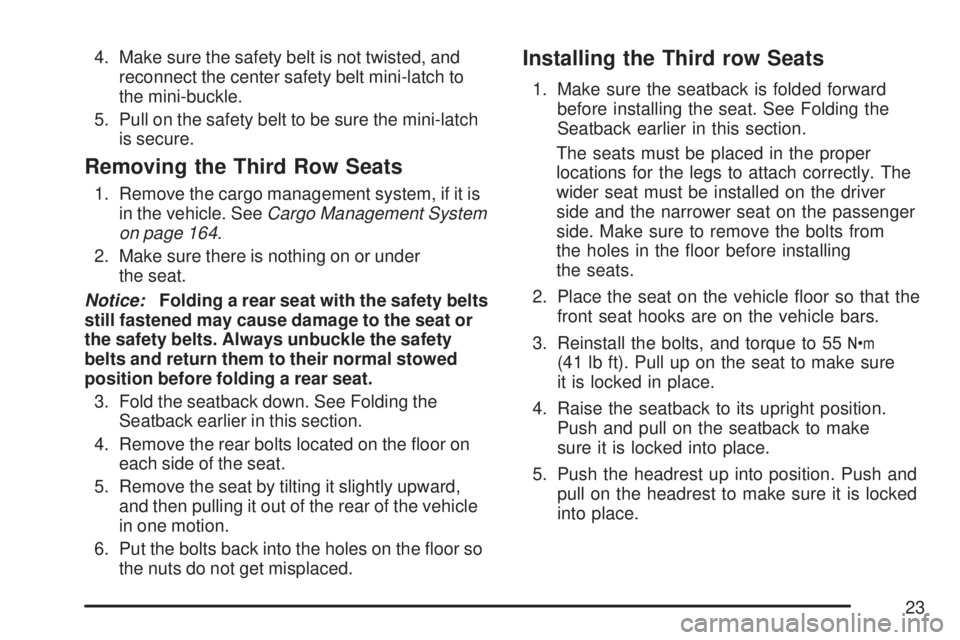
4. Make sure the safety belt is not twisted, and
reconnect the center safety belt mini-latch to
the mini-buckle.
5. Pull on the safety belt to be sure the mini-latch
is secure.
Removing the Third Row Seats
1. Remove the cargo management system, if it is
in the vehicle. SeeCargo Management System
on page 164.
2. Make sure there is nothing on or under
the seat.
Notice:Folding a rear seat with the safety belts
still fastened may cause damage to the seat or
the safety belts. Always unbuckle the safety
belts and return them to their normal stowed
position before folding a rear seat.
3. Fold the seatback down. See Folding the
Seatback earlier in this section.
4. Remove the rear bolts located on the �oor on
each side of the seat.
5. Remove the seat by tilting it slightly upward,
and then pulling it out of the rear of the vehicle
in one motion.
6. Put the bolts back into the holes on the �oor so
the nuts do not get misplaced.
Installing the Third row Seats
1. Make sure the seatback is folded forward
before installing the seat. See Folding the
Seatback earlier in this section.
The seats must be placed in the proper
locations for the legs to attach correctly. The
wider seat must be installed on the driver
side and the narrower seat on the passenger
side. Make sure to remove the bolts from
the holes in the �oor before installing
the seats.
2. Place the seat on the vehicle �oor so that the
front seat hooks are on the vehicle bars.
3. Reinstall the bolts, and torque to 55
Y
(41 lb ft). Pull up on the seat to make sure
it is locked in place.
4. Raise the seatback to its upright position.
Push and pull on the seatback to make
sure it is locked into place.
5. Push the headrest up into position. Push and
pull on the headrest to make sure it is locked
into place.
23
Page 136 of 554
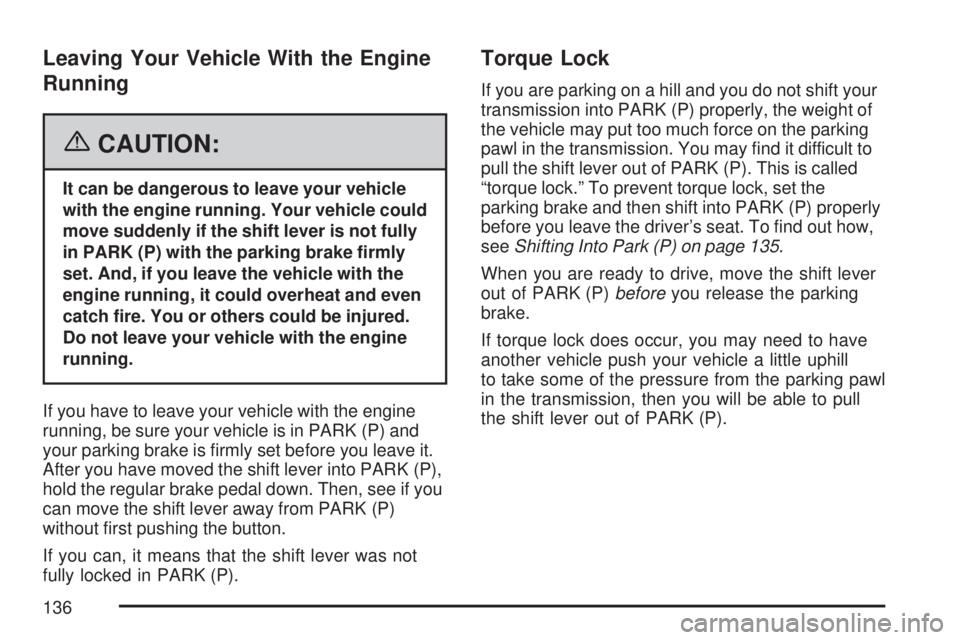
Leaving Your Vehicle With the Engine
Running
{CAUTION:
It can be dangerous to leave your vehicle
with the engine running. Your vehicle could
move suddenly if the shift lever is not fully
in PARK (P) with the parking brake �rmly
set. And, if you leave the vehicle with the
engine running, it could overheat and even
catch �re. You or others could be injured.
Do not leave your vehicle with the engine
running.
If you have to leave your vehicle with the engine
running, be sure your vehicle is in PARK (P) and
your parking brake is �rmly set before you leave it.
After you have moved the shift lever into PARK (P),
hold the regular brake pedal down. Then, see if you
can move the shift lever away from PARK (P)
without �rst pushing the button.
If you can, it means that the shift lever was not
fully locked in PARK (P).
Torque Lock
If you are parking on a hill and you do not shift your
transmission into PARK (P) properly, the weight of
the vehicle may put too much force on the parking
pawl in the transmission. You may �nd it difficult to
pull the shift lever out of PARK (P). This is called
“torque lock.” To prevent torque lock, set the
parking brake and then shift into PARK (P) properly
before you leave the driver’s seat. To �nd out how,
seeShifting Into Park (P) on page 135.
When you are ready to drive, move the shift lever
out of PARK (P)beforeyou release the parking
brake.
If torque lock does occur, you may need to have
another vehicle push your vehicle a little uphill
to take some of the pressure from the parking pawl
in the transmission, then you will be able to pull
the shift lever out of PARK (P).
136
Page 423 of 554
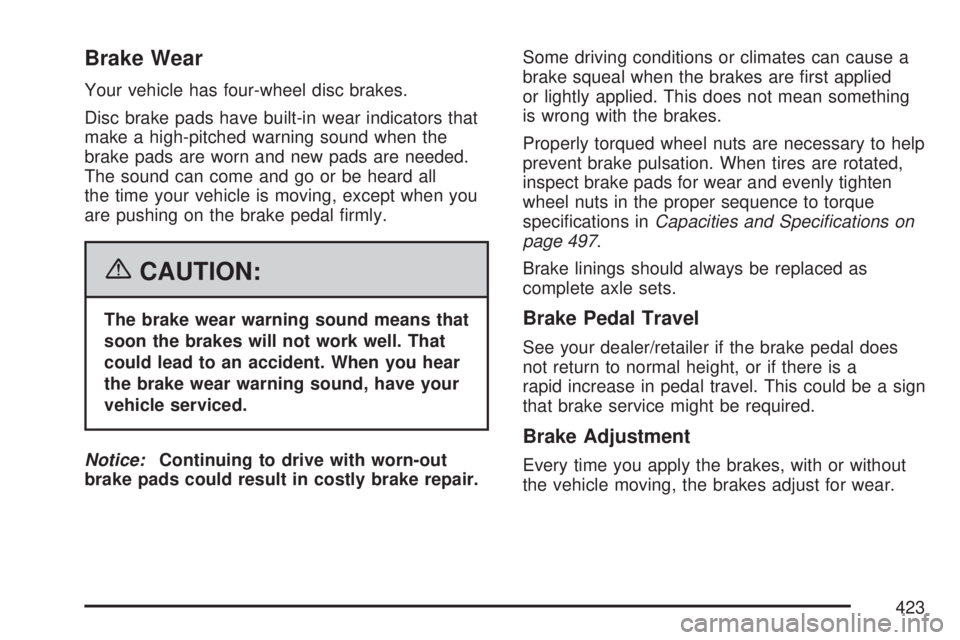
Brake Wear
Your vehicle has four-wheel disc brakes.
Disc brake pads have built-in wear indicators that
make a high-pitched warning sound when the
brake pads are worn and new pads are needed.
The sound can come and go or be heard all
the time your vehicle is moving, except when you
are pushing on the brake pedal �rmly.
{CAUTION:
The brake wear warning sound means that
soon the brakes will not work well. That
could lead to an accident. When you hear
the brake wear warning sound, have your
vehicle serviced.
Notice:Continuing to drive with worn-out
brake pads could result in costly brake repair.Some driving conditions or climates can cause a
brake squeal when the brakes are �rst applied
or lightly applied. This does not mean something
is wrong with the brakes.
Properly torqued wheel nuts are necessary to help
prevent brake pulsation. When tires are rotated,
inspect brake pads for wear and evenly tighten
wheel nuts in the proper sequence to torque
speci�cations inCapacities and Specifications on
page 497.
Brake linings should always be replaced as
complete axle sets.Brake Pedal Travel
See your dealer/retailer if the brake pedal does
not return to normal height, or if there is a
rapid increase in pedal travel. This could be a sign
that brake service might be required.
Brake Adjustment
Every time you apply the brakes, with or without
the vehicle moving, the brakes adjust for wear.
423
Page 449 of 554
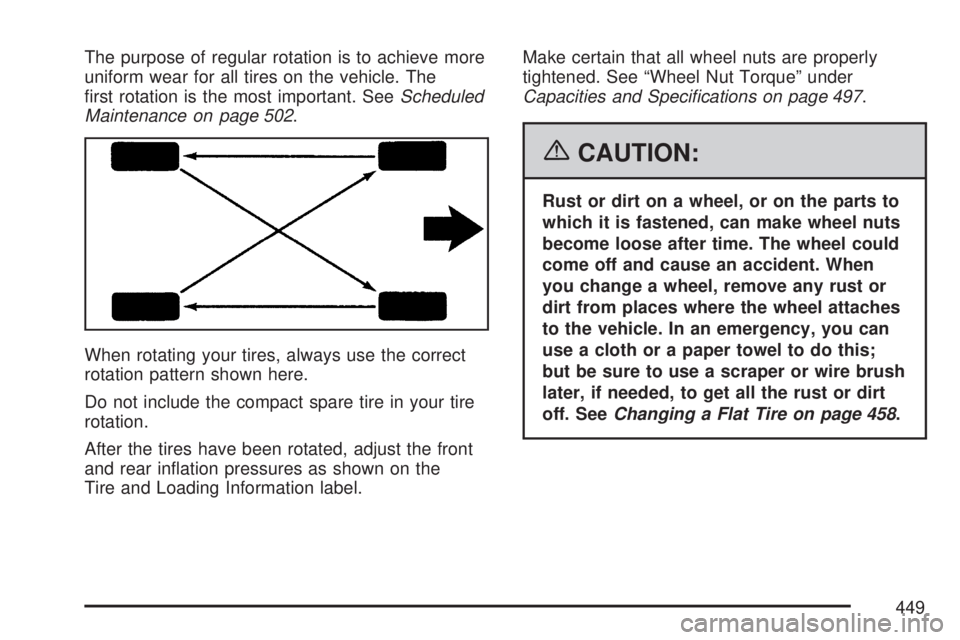
The purpose of regular rotation is to achieve more
uniform wear for all tires on the vehicle. The
�rst rotation is the most important. SeeScheduled
Maintenance on page 502.
When rotating your tires, always use the correct
rotation pattern shown here.
Do not include the compact spare tire in your tire
rotation.
After the tires have been rotated, adjust the front
and rear in�ation pressures as shown on the
Tire and Loading Information label.Make certain that all wheel nuts are properly
tightened. See “Wheel Nut Torque” under
Capacities and Specifications on page 497.
{CAUTION:
Rust or dirt on a wheel, or on the parts to
which it is fastened, can make wheel nuts
become loose after time. The wheel could
come off and cause an accident. When
you change a wheel, remove any rust or
dirt from places where the wheel attaches
to the vehicle. In an emergency, you can
use a cloth or a paper towel to do this;
but be sure to use a scraper or wire brush
later, if needed, to get all the rust or dirt
off. SeeChanging a Flat Tire on page 458.
449
Page 467 of 554
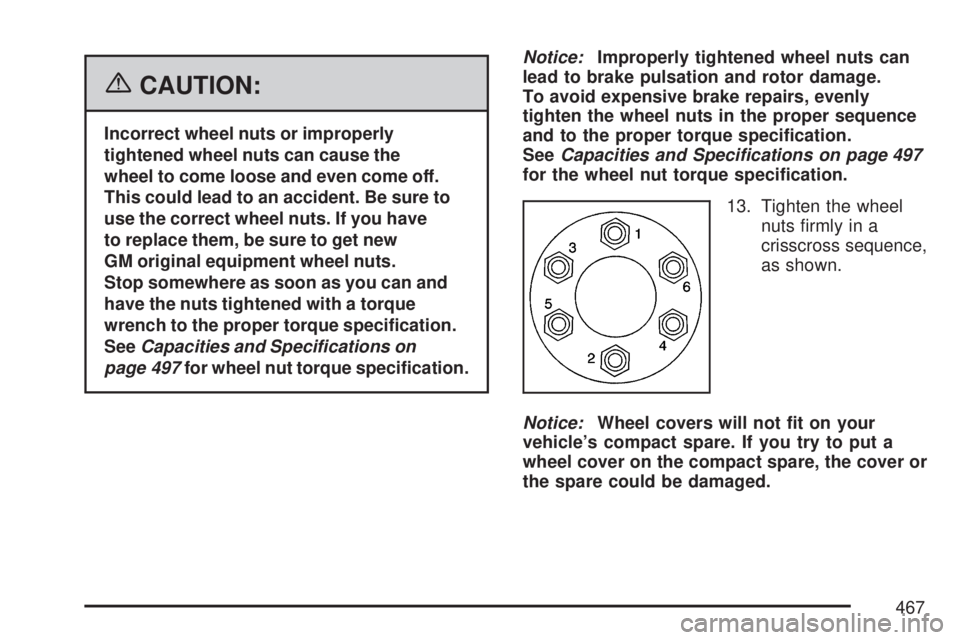
{CAUTION:
Incorrect wheel nuts or improperly
tightened wheel nuts can cause the
wheel to come loose and even come off.
This could lead to an accident. Be sure to
use the correct wheel nuts. If you have
to replace them, be sure to get new
GM original equipment wheel nuts.
Stop somewhere as soon as you can and
have the nuts tightened with a torque
wrench to the proper torque speci�cation.
SeeCapacities and Specifications on
page 497for wheel nut torque speci�cation.Notice:Improperly tightened wheel nuts can
lead to brake pulsation and rotor damage.
To avoid expensive brake repairs, evenly
tighten the wheel nuts in the proper sequence
and to the proper torque speci�cation.
SeeCapacities and Specifications on page 497
for the wheel nut torque speci�cation.
13. Tighten the wheel
nuts �rmly in a
crisscross sequence,
as shown.
Notice:Wheel covers will not �t on your
vehicle’s compact spare. If you try to put a
wheel cover on the compact spare, the cover or
the spare could be damaged.
467
Page 497 of 554
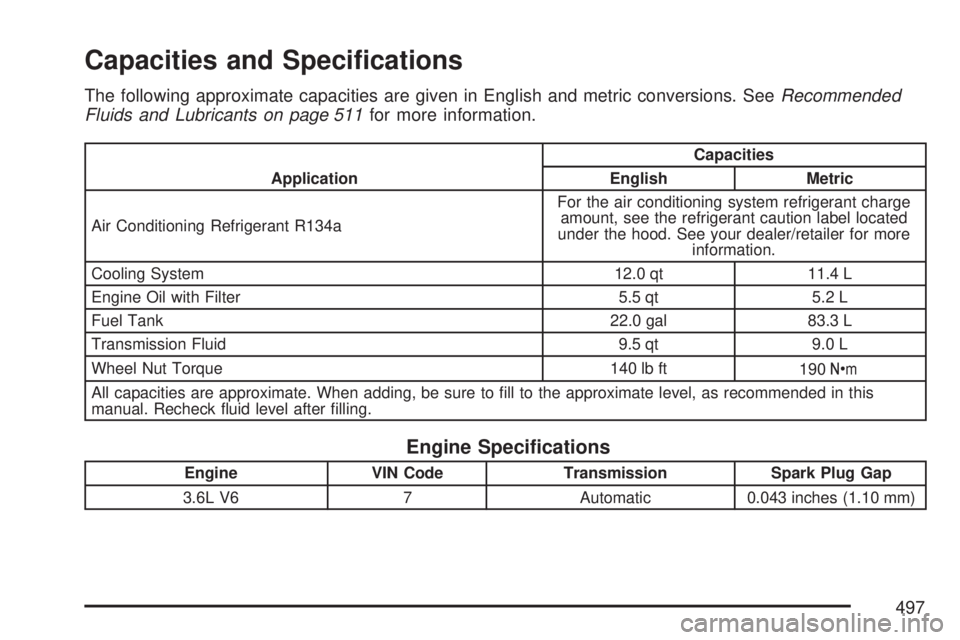
Capacities and Speci�cations
The following approximate capacities are given in English and metric conversions. SeeRecommended
Fluids and Lubricants on page 511for more information.
ApplicationCapacities
English Metric
Air Conditioning Refrigerant R134aFor the air conditioning system refrigerant charge
amount, see the refrigerant caution label located
under the hood. See your dealer/retailer for more
information.
Cooling System 12.0 qt 11.4 L
Engine Oil with Filter 5.5 qt 5.2 L
Fuel Tank 22.0 gal 83.3 L
Transmission Fluid 9.5 qt 9.0 L
Wheel Nut Torque 140 lb ft
190Y
All capacities are approximate. When adding, be sure to �ll to the approximate level, as recommended in this
manual. Recheck �uid level after �lling.
Engine Speci�cations
Engine VIN Code Transmission Spark Plug Gap
3.6L V6 7 Automatic 0.043 inches (1.10 mm)
497